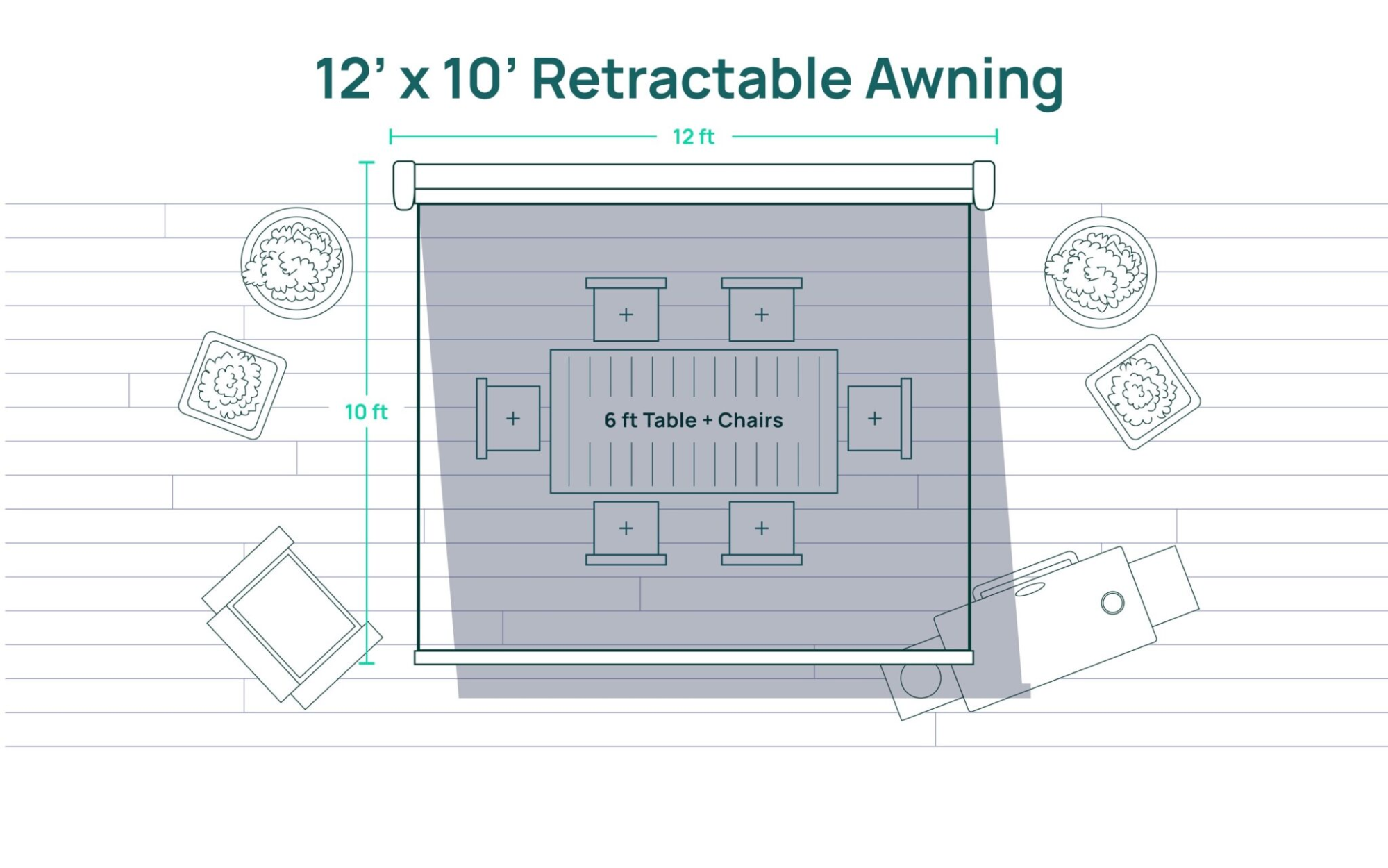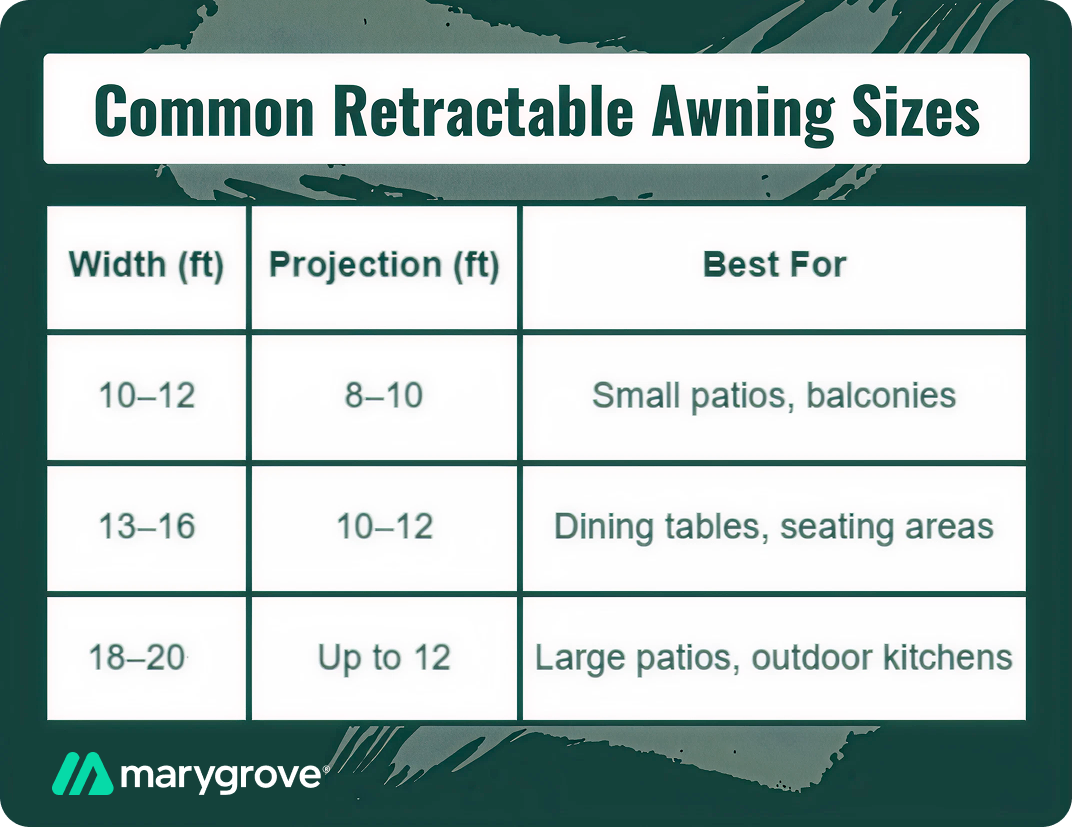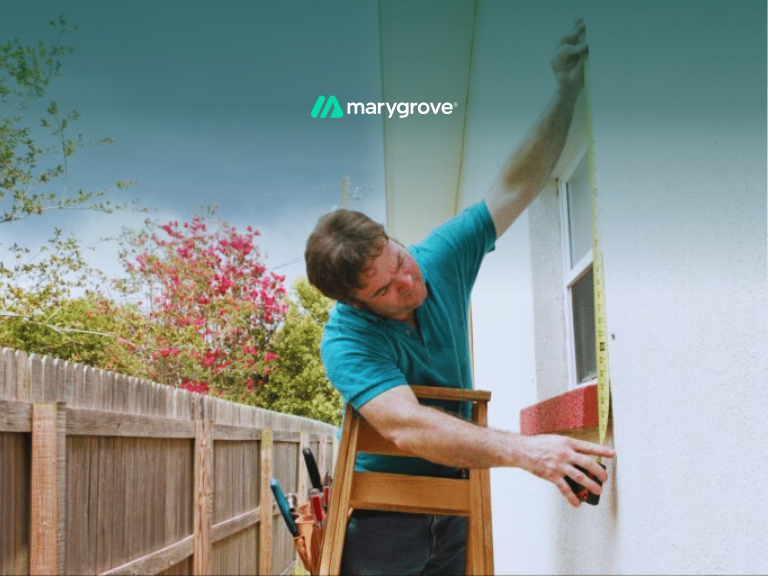Retractable awning sizes typically range from 10×8 ft for small patios to over 20×12 ft for large outdoor spaces, with 12×10 and 16×12 ft being the most commonly used.
Choosing the Right Awning Size: What You Really Need to Know
Whether it’s a small balcony or a full dining area, awning size directly impacts comfort, coverage, and curb appeal.
Most homeowners choose from three common size ranges based on how they use their space. Quick sizing insights:
- 10–12 ft wide x 8–10 ft projection – Ideal for balconies and small patios.
- 13–16 ft wide x 10–12 ft projection – Best for seating and dining zones.
- 18–20 ft wide x up to 12 ft projection – Best for large patios and outdoor kitchens. Beyond 20×12 ft, projection becomes unsafe and isn’t recommended.
Size isn’t just about space, it’s also about mounting height, pitch, sun direction, and how you use your outdoor area.
From smart features to installation, every inch matters.
And if you’re serious about long-term comfort and function, you’ll want to read this guide all the way through.
How Awning Size Impacts Comfort, Shade, and Home Value

Choosing the right awning size affects more than just looks, it shapes how you use your outdoor space and how your home feels overall.
- Use of Space: A properly sized awning lets you enjoy breakfast in the morning sun or host shaded dinners. Too small, and part of your space stays exposed. Too large, and it may block windows or feel overwhelming.
- Home Value Boost: A well-placed awning adds curb appeal and creates a finished outdoor area that’s attractive to future buyers. It can also help lower indoor temps by blocking direct sun.
- Avoid Size Regrets: Oversized awnings may make interiors darker. Undersized ones often miss key areas like dining tables or seating zones.
Planning for the right projection, height, and angle helps avoid these issues from the start.
Getting the size right means more than avoiding discomfort, it means making the most of your space, improving energy efficiency, and adding real value to your home.
So, what sizes actually work best for different spaces?
Let’s break down the most popular options and when to use them.
Common Retractable Awning Sizes (Plus a Handy Comparison Chart)

Retractable awnings come in a range of sizes, but most homeowners stick to a few standard options based on how they use their space.
The key is matching the width (wall span) and projection (how far it extends) to your layout. Larger projections offer more shade but need more mounting height.
Below is a quick breakdown of common size ranges and what they’re typically used for
r adipiscing elit. Ut elit tellus, luctus nec ullamcorper mattis, pulvinar dapibus leo.

The most frequently chosen sizes tend to be 12×10 ft and 16×12 ft—these provide a balanced mix of shade and space for the majority of deck and patio layouts.
They’re especially useful for setups that involve outdoor seating or entertaining without overwhelming the home’s exterior.
For larger areas, 18–20 ft wide with up to 12 ft projection is typically the maximum safe size; anything beyond 20×12 ft in projection can compromise structural stability and isn’t recommended.
Knowing the most common sizes is a great starting point, but to choose the perfect awning, you’ll need to look beyond the chart.
That means understanding the specific measurements that impact fit, performance, and install.
The 5 Key Measurements You Need to Know Before Choosing an Awning
Before choosing an awning, it’s important to understand the key dimensions that affect performance, fit, and overall safety:
- Width (Tip-to-Tip): This is the full length from end cap to end cap, not just the fabric. To shade a 12-foot area, order a 12-foot awning. Fabric is slightly narrower by design.
- Projection (How Far It Extends): This is how far the awning reaches outward from the wall. Common projections range from 8 to 12 feet. Larger projections need more mounting height and withstand greater wind force.
- Fabric Width: Fabric is about 5 inches narrower than the total frame. Plan accordingly if you’re trying to cover furniture or seating completely.
- Mounting Height: You’ll need at least 7’6″ from ground to mounting point. If your space is tight, roof brackets can help raise the height.
- Pitch (Tilt Angle): Pitch affects how well rain drains and how much shade you get during different times of day. Adjustable pitch arms give better control.
Also check for obstructions, like lights, downspouts, or wall-mounted items, that could affect installation or limit your size options.

Once you understand these five key measurements, you’ll have a clearer picture of what your awning needs to do, and what your space can handle.
Now let’s walk through how to measure everything properly for an awning before making a final decision.
Step-by-Step Guide to Measuring for a Perfect Retractable Awning Installation!
Before you choose an awning size, you’ll need a few basic tools and a good understanding of your space. Follow these steps to get it right the first time:
Step 1: Gather the Right Tools
You’ll need:
- A tape measure (preferably 25 ft+)
- A sturdy ladder
- A pencil and notepad
- A sun-tracking app or compass (to understand sunlight angles)
Step 2: Measure the Width of Usable Wall Space
Measure the clear horizontal space available on your wall or mounting surface. Don’t include areas blocked by chimneys, lights, or downspouts.
This will determine your maximum awning width.
Step 3: Measure Vertical Clearance
Make sure there’s at least 7 feet 6 inches from the ground to your mounting point. If you’re short on height, roof brackets may be required to raise the awning above windows or doors.
Step 4: Consider the Sun’s Path
Sun direction matters.
East-facing spaces get morning light; west-facing ones get intense afternoon sun. If you’re trying to block heat in the evenings, choose a wider or deeper projection.
Step 5: Decide What You’re Trying to Cover
Are you shading a dining table? A sitting area? A hot tub?
Knowing the layout helps determine how wide and how far out your awning should go.
Bonus Tip: Understand Usable vs. Advertised Projection
Awning arms may project 10 or 12 feet, but the angle (pitch) and your mounting height affect how much usable shade actually hits the ground.
Steeper angles reduce horizontal coverage, so plan for the real-world result, not just the product specs.
With the right tools and a few careful measurements, you can avoid sizing mistakes that lead to poor coverage or awkward installation.
But even with good prep, there are limits to what DIY measuring and off-the-shelf options can deliver, especially when every inch counts.
Why DIY Measurements and Pre-Made Awnings Often Miss the Mark
Ordering a pre-made awning online might seem easy, but it often leads to poor fit and long-term frustration.
- One-Size Doesn’t Fit All: Standard sizes rarely match your wall space or shade needs. Too shallow? You’ll miss coverage. Too wide? You’ll hit obstacles like downspouts or trim.
- Pitch Problems: Mounting too low or without adjusting the angle can cause water to pool or reduce walk-through clearance.
- DIY Risks: Poor mounting can lead to sagging fabric, uneven frames, or loosened brackets over time.
- Real-World Regret: Many homeowners end up saying, “It looked right online, but now it flaps in the wind and doesn’t even cover the table.”
Fixing these issues later often costs more than doing it right the first time, with proper sizing and professional help.
That’s why cutting corners with generic sizing or DIY installs often leads to disappointment.
If you want an awning that looks right, fits right, and lasts, custom sizing and expert installation are the smarter choice.
Helpful Resource → How Much Do Retractable Awnings Cost in 2025? [Full Pricing Guide]
Why Custom Sizing and Professional Installation Make All the Difference

Not all awnings, or outdoor spaces, are the same.
Getting the size right means more than just measuring; it’s about matching the awning to your layout, lifestyle, and local conditions.
That’s where custom sizing and professional installation make all the difference.
1. Custom Sizing: Built to Fit Your Space
Custom sizing ensures your awning is made to match your layout, not the other way around. It gives you better shade, cleaner installation, and a smarter fit.
- Tailored inch-by-inch for patios, decks, and even tricky spots with chimneys or soffits.
- Supports smart tech like wind sensors, weather-based auto-retraction, and app control.
- Drop valances and bug screens install cleaner with proper size planning.
- Marygrove’s Mint Program offers our most requested sizes, like 12×10 and 16×12, for faster delivery with professional adjustments.
2. Professional Installation: Built to Last
Size means nothing without the right installation. Professional crews understand the real-world challenges that online guides miss.
- Assess wind exposure, roof slope, and bracket strength.
- Adjust for proper pitch and head clearance during install.
- Set motor direction, cord routing, and fascia mounting cleanly and safely.
- Prevent sagging, stress on mounting points, and installation errors.
3. Built Right from the Start
When you combine custom sizing with expert installation, you get a seamless fit, safer operation, and an awning that lasts for years, not seasons.
It’s the difference between just adding shade and upgrading your entire outdoor space.
When your awning is built to fit your space and installed by professionals, everything works better, looks, performance, and peace of mind.
It’s a long-term investment in comfort, safety, and outdoor living done right.
Wrapping Up – What to Do Next to Make Sure You Get the Right Size the First Time?
Choosing the right awning size isn’t something you should have to guess. With the right tools and guidance, it’s easier than most homeowners expect.
Start by using a visualizer tool to see how different sizes will look on your home, this gives you a clear picture before you commit.
Then, schedule a free consultation with Marygrove.
Our team will assess sun direction, structure type, and your lifestyle needs to recommend the perfect fit.
If time is a factor, ask about our Mint Program, our most popular awning sizes are stocked and ready for fast installation, no guesswork involved.
The bottom line?
Don’t base your decision on price alone.
Luscri Family Retractable Awning Testimonial
An awning is a long-term upgrade, and getting the size right the first time means fewer headaches and more comfort for years to come.
Let’s make sure your outdoor space gets the shade it truly deserves, book your consultation with Marygrove today.


